Solar energy storage – what are your options?
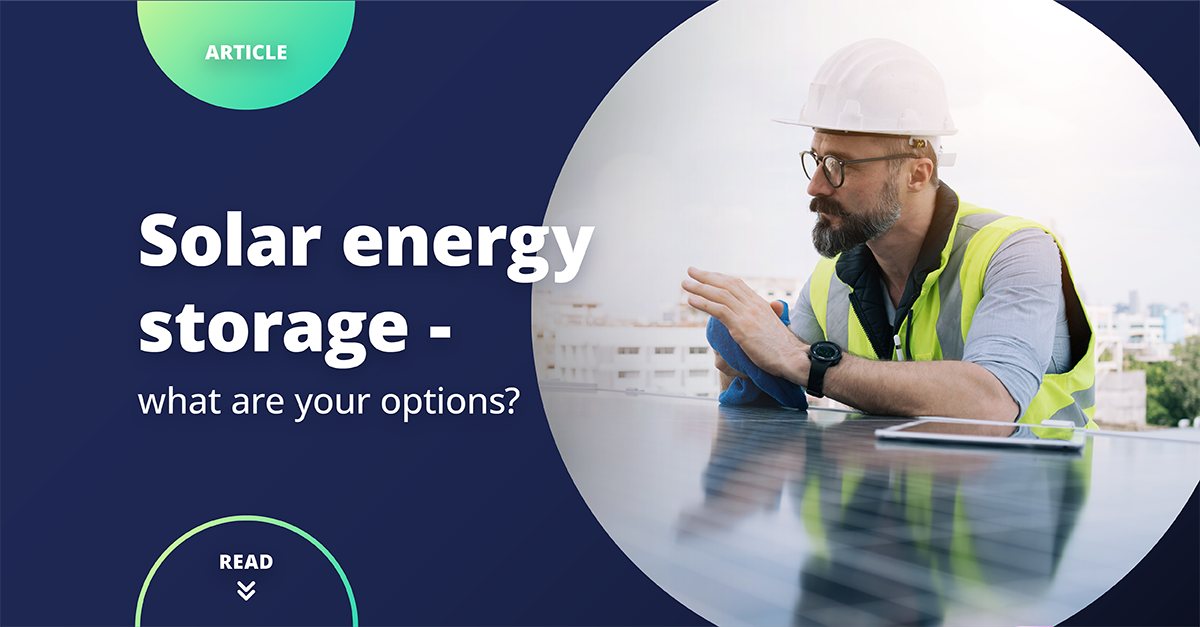
In our previous article, we looked at how many benefits turning to solar energy can give to businesses. The power generated from the sun is cheaper, cleaner, and fully renewable, and as the installations are getting more efficient every year, they can now generate far more energy than in past years. That way, solar energy is becoming one of the most effective ways to reduce our dependence on fossil fuels, carbon emissions, and also our energy bills.
But even the biggest fans of using solar energy have to admit that solar panels have two significant weaknesses: they only produce electricity when the sun is shining, and the solar panels themselves can’t store the energy for later use. So does it mean solar panels will hardly be useful for cloudy or winter days when their efficiency visibly drops?
No – you can keep using solar energy in the evenings or during dark winter times, as long as you use a solar energy storage system.
How does it work, though, and what are the most common types of solar storage available now? Find out everything you need to know about solar energy storage technology and its benefits by reading on!
What is solar energy storage?
Solar energy storage is devices that can gather the electricity generated by the solar panels, store it inside the device and then release it when the energy is needed – for example, after sundown or during power outages.
How much energy you can store depends on the type of storage system and its energy capacity, meaning how much energy it can hold at a given time. An average solar battery has a total of about 10 kWh, though there are also batteries that can store up to 13.5 kWh.
Thermal or hydro storage systems can store far more energy inside themselves (Pumped Hydro Storage capacity is, on average, 100 times higher than any available battery solution), but they are also far more complicated and costly to build.
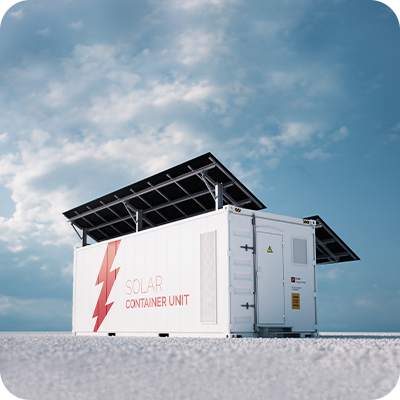
Why is having an energy storage system so important for solar panel owners?
The interest in solar panel systems is booming as homeowners and businesses are looking for ways to lower their energy costs and become more environmentally friendly. For example, the number of solar panels installed by Americans in 2022 would be enough to power 22 million homes – and that’s when we capture and turn to electricity only a fraction of the sunlight power.
As they are, solar panels also have some limitations though.
The main disadvantage is that the panels can only generate energy when the sun shines on them. So during cloudy weather or winter when it’s getting dark quickly, the solar panels’ efficiency naturally drops. On the other hand, during sunny days the solar panels often generate far more energy than needed – but the power might be wasted since panels can’t store it themselves.
Solar energy storage systems can solve both of those problems though, as they can gather the excess electricity, store it and then let companies use it whenever they need it. With the capacity of some of the storage systems, businesses can even gather energy in summer (when renewable energy sources are producing more electricity than needed) and then use it to power their company in winter, when there is a high demand for electricity but a low supply of solar energy.
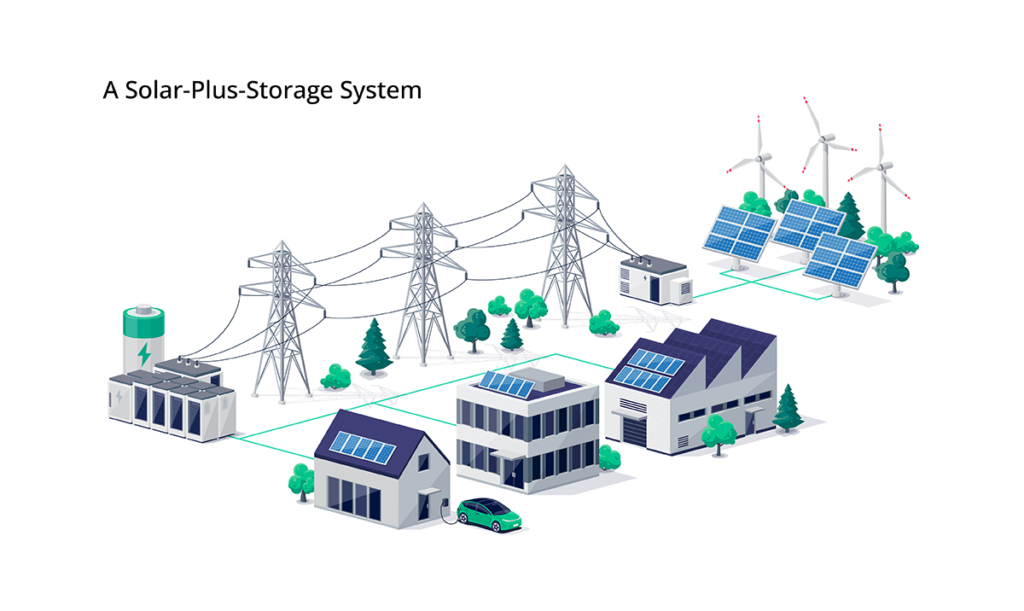
Solar panels with storage devices are becoming increasingly popular as a backup energy source in case of power outages (for example, during severe weather) when the panels cannot produce energy. Why is that?
Unless solar panel owners decide to go entirely off-grid, the panels are usually still connected to the grid. That way, you can draw electrical power from your utility provider when your system isn’t generating enough energy, and you can also send excess energy to the grid for credit in many states (this is called net metering). For safety reasons though, all grid-tied solar energy inverters are required to automatically shut down when the electric grid goes down and the power goes off. That means when the power grid is down, the solar panels are not working either.
When you have a solar storage system though, the outages aren’t as much of a problem as you can just connect to the storage and draw the necessary energy from there.
What are the main types of solar energy storage?

Choosing the best method of storing the energy coming from the panels might be slightly tricky because of the variety of different types of storing energy available now. On one side, that allows companies to choose the best storage method for their needs – the downside is that it can be quite confusing to understand how each storage method works and their requirements.
Let’s have a quick look at the available solar energy storage types and their main features.
1. Solar batteries
Solar batteries are now one of the most commonly used devices for storing solar energy, mainly thanks to how much cheaper they have gotten in recent years.
The price of Lithium-ion batteries has fallen 89% from more than $1,200/kWh in 2010 to $132/kWh in 2021, making them much more affordable for households or smaller businesses. They are now also one of the easiest ways to have a backup power source when the panels don’t generate enough energy or the grid electricity supply has been cut.
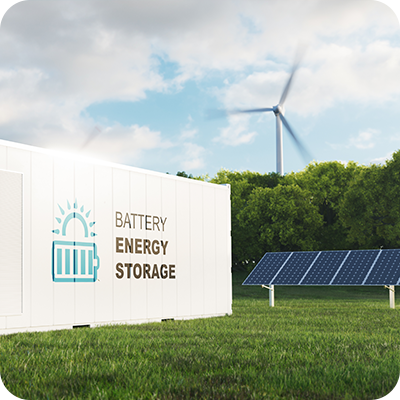
There are four types of solar batteries available on the market now:
- Lead-acid batteries: Lead batteries have been on the market for decades, and they are still pretty popular. They are known for being reliable, plus they are one of the cheapest battery types available. Unfortunately, they are also quite bulky and heavy and should be placed in a well-ventilated area, which might limit your options for where to place them. Lead batteries also have a lower-than-average lifespan (from 5 to 10 years) and require regular maintenance to keep them in the best condition possible.
- Lithium-Ion batteries: They are one of the newer battery types but they quickly gained popularity as they are much smaller and lighter than lead batteries and can store more energy inside them. Their lifespan is also much better than the lead batteries (they can keep working for 10-15 years) and require little to no maintenance. However, even though the price of lithium batteries is quickly dropping, they are still one of the more expensive types.
- Nickel-cadmium batteries: Ni-Cd batteries are very durable and can function even in extreme temperatures, so they are often used for solar energy storage. Their main disadvantage is that cadmium is a highly toxic element that can have a significant negative impact on our environment, so disposing of them is, unfortunately, quite problematic.
- Flow batteries: Flow batteries are a new type of battery where a water-based electrolyte flows between battery chambers or tanks. As they can be extended to virtually any desired capacity just by adding extra tanks and have far longer longevity than any other battery type (even up to 30 days), they are gaining popularity. The main problem, for now, is that the tanks must be pretty large, making them very expensive and difficult to set up.
The main problem with all available battery technology types is that their lifespan is the shortest of all available storage systems – on average from 5 to 10 years. Their capacity is also limited, so depending on whether they want to use the solar storage only as a backup or they want to go off-grid, businesses will often need more than one battery to cover their needs – and that might significantly up the installation cost.
2. Thermal storage system
The second option is to use a thermal storage system. Thermal energy storage uses a fluid (such as molten salt) or a solid material to gather the heat and then store it in an insulated tank until the energy is needed. The heat can later be converted into superheated steam to power turbines and generate electricity.
As thermal storage systems can store large amounts of energy for months, that makes them a good option for companies that want to ensure they have enough energy for daily use during times when solar production drops. What’s more, molten salt thermal energy storage can be heated and cooled daily for at least 30 years. The downside is that thermal storage systems require plenty of space as the tanks have to be pretty large – which also means that the upfront costs might be quite high.
3. Pumped-Storage Hydropower
According to the 2021 edition of the Hydropower Market Report, Pumped-storage hydropower systems currently account for 93% of all utility-scale energy storage in the United States. Here, electrical energy is used to pump water uphill into a reservoir when energy demand is low and then the water is allowed to flow back downhill and turn a turbine to generate electricity when demand is high. The water can then cycle between upper and lower reservoirs for decades.
Setting up a pumped hydro storage system is a pretty complicated process though, as it requires plenty of space, a suitable landscape (the reservoirs must be at different elevations), and also natural or man-made places that will act as water reservoirs. That means that building such a storage system might take years, as companies will need to find a suitable location, get all required regulatory permits, plan the installation, and then start the system construction. Obviously, it also means that this method of storing energy will require a large upfront capital investment as well.
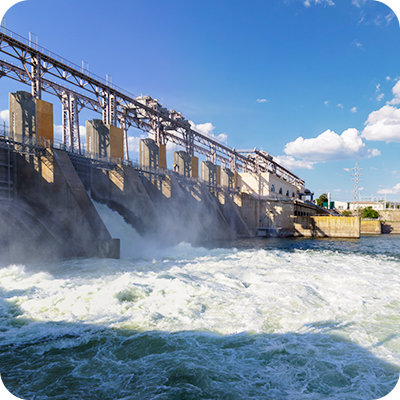
In addition to those three methods, energy can also be stored in the following ways:
- Compressed air energy storage: The energy is stored as compressed air in high-pressure, often underground, tanks. The pressure is then released when the power demand spikes and the extending air powers up the turbines to generate electricity.
- Flywheel Energy Storage: A flywheel energy storage system stores the energy by converting it into kinetic energy and then using it to rotate a rotor. When the stored energy is needed, the spinning force drives a device similar to a turbine to produce electricity, slowing the rate of rotation.
- Liquid Air Energy Storage system: Utilizes excess power going from the panels to cool ambient air to liquid form and then store it. To release the energy, the air can be heated and then used to power turbines.
Scientists are also working on using hydrogen as a storage device for renewable power, as it could allow large amounts of clean energy to be stored for long periods. For now, though, hydrogen is rarely used as it’s difficult to extract, highly flammable, and difficult to transport and store.
How to pick the suitable solar energy storage method?
So what is the best energy storage option? Sadly, we can only answer this question with “it depends on what you need.” To pick the right technology, you should first research your main goals for energy storage systems, how much storage capacity you will need the systems to have, and if there are any additional requirements the storage systems should meet.
Adding a solar battery (or batteries) is usually the fastest way to add a storage system to the solar panels. As their capacity and lifespan are limited though, they might not be a good solution if your business has large energy needs. In this case, you might need several batteries to cover your needs and the installation costs might become staggering.
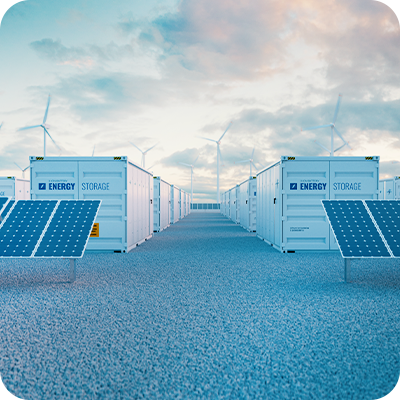
Thermal or hydro storage can store a much more significant amount of energy at one time, allowing companies to store months’ worth of power at a time. Plus, they can also keep working for several years with little maintenance needed. Installing those is a major investment though, both when it comes to the time necessary to plan and finish the installation, and the cost involved.
Deciding on the storage solution that fits your business needs the most is just the beginning though. To make the most of the stored energy, you might also need a solution to manage the storage systems and keep an eye on the energy consumption. Fortunately, that’s something with which we at Codibly can help you.
With over ten years of experience working with clients in the energy and renewables industries, we know solar power inside and out, so we can quickly match the right solution to your needs. Whether you need someone to design a solar energy monitoring system, help you optimize your solar battery storage usage, or make it easier to manage multiple different energy resources, we are sure to have an idea (and skills) how to do it.
Conclusion
The sun offers a limitless supply of clean power – and thanks to solar panel systems getting more efficient all the time, harnessing it is no longer a problem. Storing the gathered solar energy can be a bit more problematic though – unless you have installed a solar storage system. With those, you can store enough energy to power your business with solar energy even when the panels don’t generate as much electricity as usual – and lower your energy bills and carbon footprint even further.
With Codibly’s help, you can also ensure that your storage systems work at 100% of their capabilities – and the extra power will always be available when you need it.
contact us
Need expert guidance on your next energy project?
Reach out to us and discover how Codibly can offer tailored solutions to drive your business.